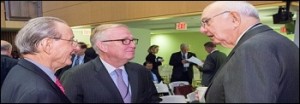By Pam Martens and Russ Martens: June 24, 2015
By any measure, the taxpayer bailouts and Federal Reserve loans of more than $13 trillion infused into the banking system during and after the 2008 financial collapse eclipse any other period in U.S. history. A growing body of research now suggests that these bailouts have set us up for ever greater episodes of moral hazard.
Kartik B. Athreya, writing for the Richmond Fed, has described moral hazard this way:
“As for implicit guarantees as a source of systemic risk, the idea is this: Any belief among financial market participants especially creditors, that they will be made whole by the public in the event of the failure of the assets they finance (i.e., that they will be ‘bailed out’) will lead them, all else equal, to (i) take greater risks, even if that means becoming ever more opaque or interconnected, and (ii) grow too large.”
Frequently cited as prior misguided adventures into moral hazard by the U.S. government is the bailout of Continental Illinois National Bank in 1984 and the Federal Reserve’s intervention in the Long-Term Capital Management crisis in 1998, where high-risk gambles in derivatives by an obscenely leveraged hedge fund blew up.
There is another stunning example of moral hazard that is rarely discussed today; perhaps because it occurred on the watch of former Fed Chairman Paul Volcker who was intimately involved in fashioning financial reform after the 2008 crisis.
At the June 30, 1982 meeting of the Federal Open Market Committee (FOMC) of the Federal Reserve, Chairman Volcker asked the Board to approve a $700 million loan to Mexico. As a bit of background, according to Fed data, in 1982 the largest U.S. banks held Latin American debt amounting to 176 percent of their capital. Regulators allowed this hubris to occur and now the Fed was preparing to bail them out of their jaded actions.
The following incredible exchange among Fed Governors occurs according to the transcript of the FOMC Meeting:
FORD. Have we looked at the banks? That is another concern. The last time I looked at the major U.S. banks, many of them had half their capital committed in Mexico.
CHAIRMAN VOLCKER. Mexico has become the world’s largest borrower, exceeding Brazil in the past year. And what is the amount from American banks alone?
VICE CHAIRMAN SOLOMON. $20 odd billion.
CHAIRMAN VOLCKER. Well, that’s big.
TRUMAN. It’s $21-1/2 billion.
CHAIRMAN VOLCKER. And that is part of their problem–that the banks are nervous anyway. They have lots of reasons to be nervous both domestically and internationally. They are choked up to the back of the throat anyway and they feel a lot more choked up now than they did last year when they were getting there.
VICE CHAIRMAN SOLOMON. I don’t think we really have any alternative…
Prior to the above exchange, Chairman Volcker explained how the Fed had become the lender of last resort to Mexico, rather than banks. Volcker states:
CHAIRMAN VOLCKER: …They [Mexico] have obviously tried some borrowing in the private markets. They spent a lot of time negotiating a big loan of $2-1/2 billion and they signed up the lead banks well over a month ago as I recall. The banks went out and tried to syndicate it…The banks found out during this period in going out and syndicating the loan that there was very little response, which I think is symptomatic of banking attitudes toward Mexico at this point. So the leaders in the syndicate got stuck with most of the loan because they had agreed to underwrite it. The loan presumably went through today finally. It was going to be signed every week and never got signed. I presume it got signed today. But by this time there is no money left of the loan because half of it goes into refinancing short-term debt that these same banks had put on some time ago and the other half goes to repay a bridge loan that they had made when they agreed to make the loan in the first place. So, there isn’t any cash from the loan. And it’s all symptomatic of the international financial markets closing up pretty tightly on Mexico now.
Bloomberg News was forced to fight a multi-year court battle against the Federal Reserve to make former Fed Chairman Ben Bernanke reveal the borrowings through its discount window during the financial crisis of 2008 and years following. When Bloomberg News finally won that battle, here it what it reported:
“The biggest borrowers from the 97-year-old discount window as the program reached its crisis-era peak were foreign banks, accounting for at least 70 percent of the $110.7 billion borrowed during the week in October 2008 when use of the program surged to a record. The disclosures may stoke a reexamination of the risks posed to U.S. taxpayers by the central bank’s role in global financial markets.”
Instead of stoking a reexamination of the risks posed by the Fed’s secret actions, Congress gave the Federal Reserve vastly expanded bank regulatory powers under the Dodd-Frank financial reform legislation. It became the regulator of first resort and the lender of last resort.
If you want to attempt to understand how moral hazard has permeated the U.S. financial system, there is no better place to begin than the Federal Reserve.
Related Articles:
U.S. Senate Tries Public Shaming of New York Fed President Dudley
Carmen Segarra: Secretly Tape Recorded Goldman and New York Fed
New York Fed’s Answer to Cartels Rigging Markets – Form Another Cartel
Is the New York Fed Too Deeply Conflicted to Regulate Wall Street?


